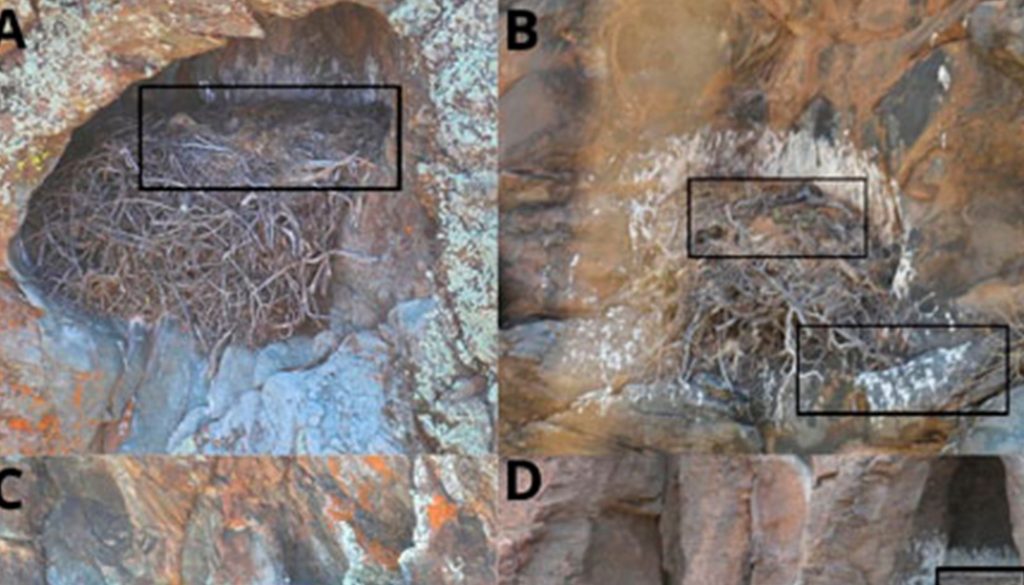Gonzalo De León-Girón a, Diego Toscano a, Gorgonio Ruiz-Campos a, *, Catalina Porras-Peña b, Fernando Escoto-Rodríguez b, Víctor Gelasio Sánchez-Sotomayor b, Celerino Montes-García b, Juan Vargas-Velazco c, Ismael Cruz-Molina d, Robert N. Fisher e
a Universidad Autónoma de Baja California, Facultad de Ciencias, Laboratorio de Vertebrados, Carretera Transpeninsular Ensenada-Tijuana No. 3917, Colonia Playitas, 22860 Ensenada, Baja California, Mexico
b Comisión Nacional de Áreas Naturales Protegidas, Av. Profesor Domingo Carballo Félix No. 202 Poniente, Col. Marcelo Rubio, 23940 Guerrero Negro, Baja California Sur, Mexico
c Espacios Naturales y Desarrollo Sustentable, Miguel Hidalgo No. 143, Barrio del Niño Jesús, Tlalpan, 14090 Ciudad de México, Mexico
d Programa de las Naciones Unidas para el Desarrollo, Montes Urales No. 440, Col. Lomas de Chapultepec, 11000 Ciudad de México, Mexico
e Western Ecological Research Center, United States Geological Survey, 4165 Spruance Road, San Diego, CA, 92101, USA
*Corresponding author: gruiz@uabc.edu.mx (G. Ruiz-Campos)
Received: 23 March 2023; accepted: 27 November 2023
Abstract
Aerial census for identification and quantification of nesting sites of Golden Eagle was performed through the mountain ranges of the central Baja California Peninsula, Mexico from 5 to 8 April 2021. We identified a total of 113 nests and 12 territories of Golden Eagle on a sampling trajectory of 1,203 km that encompassed a surface of 176,000 ha. The highest abundance of nests (n = 57) was recorded between 29º and 30º N latitudes with elevations ranging between 600 and 700 m (n = 35) in the Valle de Los Cirios Protected Natural Area, which is mainly associated with mountain biotopes with steep cliffs and ample alluvial valleys that promote foraging and nesting sites for this species. The number of nests of Golden Eagle showed an inverse relationship with the altitude along a latitudinal gradient. This study reports new nesting sites of Golden Eagle in the central peninsular region that includes the mountain ranges of Matomí, Jaraguay, and La Libertad.
Keywords: Aerial census; Baja California Peninsula; Golden Eagle; Nesting áreas
© 2024 Universidad Nacional Autónoma de México, Instituto de Biología. Este es un artículo Open Access bajo la licencia CC BY-NC-ND
(http://creativecommons.org/licenses/by-nc-nd/4.0/).
Identificación y cuantificación aérea de sitios de anidación de águila real (Aquila chrysaetos) en las montañas del centro de la península de Baja California, México
Resumen
Un censo aéreo para la identificación y cuantificación de sitios de anidación de águila real fue realizado a través de los sistemas montañosos de la parte central de la península de Baja California, México, del 5 al 8 de abril de 2021. Identificamos un total de 113 nidos y 12 territorios de águila real a través de una trayectoria de muestreo de 1,203 km que abarcó una superficie de 176,000 ha. La mayor abundancia de nidos (n = 57) fue registrada entre las latitudes 29º y 30º N con elevaciones variando entre 600 y 700 m (n = 35) en el Área Natural Protegida Valle de Los Cirios, la cual está principalmente asociada a biotopos de montaña con acantilados pronunciados y amplios valles aluviales que promueven sitios de forrajeo y anidación para esta especie. El número de nidos demostró una relación inversa con la altitud a través de un gradiente latitudinal. Este estudio reporta nuevos sitios de anidación de águila real en la región central peninsular que incluye de norte a sur a las sierras de Matomí, Jaraguay y La Libertad.
Palabras clave: Censo aéreo; Península de Baja California; Águila real; Áreas de anidación
© 2024 Universidad Nacional Autónoma de México, Instituto de Biología. This is an open access article under the CC BY-NC-ND license
Introduction
Golden eagles (Aquila chrysaetos) are considered one of the longest-lived bird species of prey (Katzner et al., 2020; Palmer, 1988; Watson, 2010) with a life span more than 30 years in the wild (Katzner et al., 2020). During the breeding season they establish nesting territories by building a series of alternative nests throughout the year in different spaces within the territory, but the eggs are only laid in one of these sites (Hunt, 1998; Katzner et al., 2020; Palmer, 1988). Alternative nests are considered as potential nests that can be utilized within their territory (Millsap et al., 2015; Steenhof et al., 2017), where the pairs exhibit high fidelity to their nesting territories (Bates & Moretti, 1994; Katzner et al., 2020; Phillips et al., 1991; Watson, 2010).
This holarctic eagle occupies a trophic position as top predator in open and semi-open habitats in several types of biomes as tundra, chaparral, grassland, temperate deciduous forest, and coniferous forest, from sea level to 3,630 m of altitude (De León-Girón et al., 2016; Katzner et al., 2020; Rodríguez-Estrella, 2002; Rodríguez-Estrella et al., 2020; Watson, 2010). In México, Golden Eagle has been historically recorded in the semi-arid mountain biotopes of Baja California, Baja California Sur, Sonora, Chihuahua, Durango, Sinaloa, Zacatecas, Querétaro, Hidalgo, Guanajuato, Nayarit, and some isolated records in Oaxaca (Conanp, 2008; De León-Girón et al., 2016; Farías et al., 2016; Flesch et al., 2020; Guerrero-Cárdenas et al., 2012; Pool et al., 2014; Rodríguez-Estrella, 2002, Rodriguez-Estrella et al., 2020).
Although the current population and nesting status of Golden Eagle has been widely studied in the United States of America (Hunt et al., 2017; Millsap et al., 2015; Nielson et al., 2017; U.S.F.W.S., 2016), very little is known for northern Mexico (Bravo-Vinaja et al., 2015; De León-Girón et al., 2016; Flesh et al., 2020; Rodríguez-Estrella et al., 1991; Rodríguez-Estrella et al., 2020). In northwestern Baja California, a total of 39 individuals were recorded during an aerial census in 2015, including 9 nesting territories (De León-Girón et al., 2016), indicating one of Mexico’s highest potential regions for nesting and conservation of Golden Eagle (De León-Girón et al., 2016; Rodríguez-Estrella et al., 2020; Tracey et al., 2018; 2020). In this same region, a recent population genetic study (Oyervides-Figueroa, 2019) identified the presence of Golden Eagle of both resident and migratory individuals with movements of “floater” individuals coming from southern California, in the USA.
The present study based on an aerial census identifies and quantifies the nesting sites of Golden Eagle on mountain ranges of the central region of the Baja California Peninsula, Mexico, a region that has been practically unexplored as potential habitat for the breeding area of this species. We hypothesize that the number of Golden Eagle nesting sites depends on a combination of latitude and altitude levels that are associated to mountain habitats with steep cliffs and wide alluvial valleys (plateaus) with higher prey availability. The information generated will serve as a baseline for the delimitation of critical nesting areas and the application of a monitoring protocols for this species in the Baja California Peninsula and other regions of Mexico.
Materials and methods
The aerial census for the identification and quantification of Golden Eagle nesting sites was performed in 3 protected natural areas of the central Baja California Peninsula: Sierra de San Pedro Mártir National Park (PNSSPM) and its surroundings, Valle de Los Cirios Flora and Fauna Protection Area (APFFVC), and El Vizcaíno Biosphere Reserve (RBV) (Fig. 1).
The Sierra San Pedro Mártir located in northern Baja California has an area of 72,910.68 ha, a length of 160 km, an average width of 36 km and elevations ranging from 1,000 to 3,076 m (average 1,096 m). This mountain range possesses an average annual rainfall of 350 mm, with vegetation of chaparral type between 500 and 1,200 m, where the dominant plants are Pointleaf Manzanita (Arctostaphylos pungens), Chamise (Adenostoma fasciculatum), Redshank (Adenostoma sparsifolium), Nuttall’s Scrub Oak (Quercus dumosa); above 1,200 m the vegetation is composed by conifers as Pinyon Pine (Pinus quadrifolia), San Pedro Mártir Cypress (Cupressus montana), Jeffrey Pine (Pinus jeffreyi), San Pedro Mártir Pine (Pinus contorta), California Fir (Abies concolor) and Sugar Pine (Pinus lambertina) (Delgadillo, 2004; Harper et al., 2021; Thorne et al., 2010).
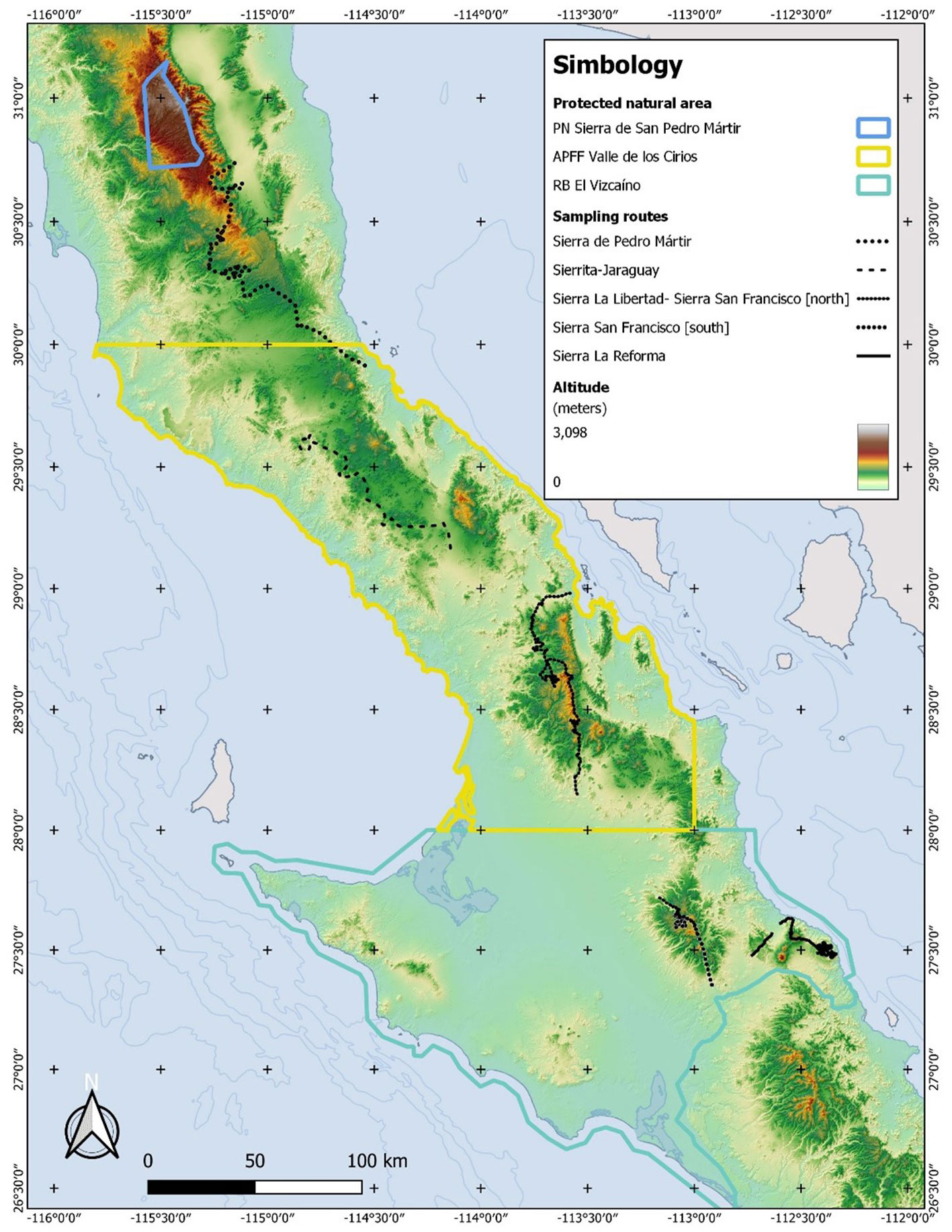
The Sierra de Matomí has a surface of 85,000 ha and a length of 40 km, with elevations from 600 to 1,100 mm, where the highest peak (Pico Matomí) is as high as 1,700 m (INEGI, 2010; Google Earth, 2005). APFFVC encompasses the central part of the Baja California Peninsula and covers an area of 2,521, 987.61 ha. Average annual temperature ranges from 18 to 22 ºC and average annual rainfall of 100 mm. In the northern section there is an 87 km long mountain range, with an average width and elevation of 42 km and 613 m, respectively (Conanp, 2013). The middle and southern sections of the APFFVC are represented by La Libertad, San Borja and Agua de Soda Mountain ranges having a respective length and width of 103 km and 54 km. Vegetation is composed by Sonoran Desert plant elements as Torote (Pachycormus discolor), elephant cactus (Pachycereus pringlei), creosote bush (Larrea tridentata), and boojum tree (Fouquieria columnaris) (Brown & Lowe, 1980; Delgadillo, 1998).
The RBV is situated in the state of Baja California Sur covering an area of 2,259,002.95 ha, with temperatures ranging from 18 to 22 ºC and an average annual rainfall between 50 and 70 mm. Two physiographic regions are recognized, the first named Coastal Plain province and the second as Mountain province, the latter one represented by the Sierra San Francisco with a length of 67 km, average width of 37 km, and elevations ranging from 89 to 1,578 m. The highest peaks in the eastern part of the RBV are Las Vírgenes, Partido, and Azufre volcanoes, as well as Sierra La Reforma with presence of exposed sulfurous green rocks (Conanp, 2000). The mountain complex has a length of 26 km and an average width of 38 km, with peaks as high as 1,305 m. Vegetation in RBV is represented by elephant cactus (Pachycerus pringlei), herbaceous plants such as Ambrosia camphorata, Erodium cicutarium and Astragalus prorifer, as well as epiphytes such as Tillandsia recurvata and lichens (Rocella tictoria) (Rebman & Roberts, 2012).
We selected the aerial sampling routes for the identification of Golden Eagle nesting sites in the study area on the basis of: 1) previous records of the presence of nests or possible nesting territories, 2) field explorations to nesting sites, 3) information obtained from experts and/or residents in the study area, and 4) use of satellite data (GPS) obtained from satellite transmitters placed on 10 Golden Eagles captured and released in San Diego County, southern California by the U.S. Geological Survey, whose home ranges during 2016 to 2019 were extended to Loreto in Baja California Sur, Mexico (Tracey et al., 2018, 2020; Wiens et al., 2022).
All the information generated during the study was integrated into a geographic information system (QGIS Version 3.28 .8-Firenze, http://www.qgis.org), using vegetation maps (1: 250,000 INEGI, 2018), topography (Topography 1:0000 INEGI, 2010), and continuum elevations of Mexico 3.0 (Datum ITRF92, INEGI, 2013), and Google Earth to establish potential nesting sites.
In the aerial census for identification and quantification of Golden Eagle nests we considered key geomorphological features such as cliffs, escarpment, and orientation for the detection of nests (Kochert & Steenhof, 2012; Marzluff et al., 1997; McGahan, 1968; Millsap et al., 2015; Watson & Duff, 2014). We performed 5 aerial routes on board of a helicopter in a parallel to the highest parts of the mountain ranges of the central Baja California Peninsula between Sierra San Pedro Mártir and Sierra La Reforma, during 5 to 8 April 2021 (Fig. 1). This period of nest quantification in this study was based on the known nesting season for this species in northwestern Mexico (De León et al., 2016). The geographical coordinates of the start and end of the sampling route in each mountain range appear in figure 1 and table 1.
This aerial monitoring was performed according to the protocols recommended by Nielson et al. (2017) and Pagel et al. (2010). Both protocols take into consideration the expertise of the observer team, type and velocity of the aircraft, interviews with local ranchers for identification of potential nesting sites in areas with cliffs. The recommended distance between the helicopter and the cliffs for detection of nests must be between 10 and 200 m. The average time of observation for each nest is 30 sec.
The aerial identification and quantification of Golden Eagle nests was carried out aboard of a Bell helicopter model 505-year 2018, traveling at an average speed of 27 km/h, the elevation of the flight was dependent on the topography of each mountain range. The flying elevation and velocity were 828 ± 215 m and 27 km/h, at a minimum distance of 80 m of the detected nests (Sharpe et al., 2001). The effective sampling length for aerial identification and quantification of Golden Eagles nests was 1,203 km for the 5 sampling routes combined, flying at an average elevation of 828 ± 215 m, an average speed of 27 km/h, and an effective sampling time of 10.1 h.
The aerial census team in the helicopter consisted of 1 pilot (who followed the census route), 1 copilot (who detected nesting sites), and 2 observers (who counted and identified Golden Eagle nests with the aid of binoculars, cameras, and videos).
Representative samples of photographs and videos were taken during the aerial sampling in each route for the classification of nests in use (UN) and alternative nests (AN), which was based on Millsap et al. (2015). The category of nests in use includes any of the following cases: 1) young were raised; 2) eggs were laid; 3) 1 adult was observed in incubation position; 4) 2 adults were observed on or near the nest and no other nests in use were present within the nesting territory that year; 5) 1 adult and 1 eagle in sub-adult plumage were observed in or near the nest and mating behavior also was observed, and no other nests in use were present within the nesting territory that year; or 6) the nest was repaired and fresh sticks and Golden Eagle feathers molted that year were present, and no other nests in use were present within the nesting territory that year. In spite of this fact categories 4) to 6) do not constitute proof a nest was in use, they are only suggestive of such (Millap et al., 2015) (Fig. 2). Additionally, a nest in use is built on proper site for supporting the weight of it, as well as shows the presence of excreta on roof and balcony, sticks and large branches, and the placement of soft materials on the central part of the nest (with shredded Yucca) (Dixon, 1937; Jollie, 1947; Postupalsky, 1974; Slevin, 1929; Watson, 2010).
Alternative nests are those within a nesting territory that are not in use in the current year (or at the current time, allowing for the rare instance of re-nesting, when eggs might be laid in 2 nests in a year). In a year when a nesting territory is occupied by a pair, but eggs are not laid (i.e., there is no nest in use), all nests in that territory are considered alternative nests (Millsap et al., 2015).
To obtain the orientation of the detected nests, we used the digital elevation model of INEGI (2013), calculating the orientation of the slopes where each nest was located, using the “Aspect” tool from the GDAL library of QGIS (QGIS Version 3.28.8-Firenze, http://www.qgis.org). The resulting aspect raster layer contains values from 0 to 360 that express the direction of the slope, starting from North (0°) and continuing clockwise.
Subsequently, a reclassification was carried out to group the values from 0 to 22.5 and 337.5 to 360 as North orientation, the values from 22.5 to 67.5 as Northeast orientation, the values from 67.5 to 112.5 as East orientation, the values from 112.5 to 157.5 as Southeast orientation, values from 157.5 to 202.5 as South orientation, values from 202.5 to 247.5 as Southwest orientation, values from 247.5 to 292.5 as West orientation, and values from 292.5 to 337.5 as Northwest orientation. Finally, the raster value corresponding to the specific location of each nest was assigned.
We used the Pearson correlation (r) to test if the number of Golden Eagle nests is related to the latitude or altitude factor. Complementarily, a goodness of fit test (c2) was used to determine if the observed frequency of Golden Eagle nests (all nests identified) exhibited a significant preference for any altitude (400-600 m, 601-800 m, 801-1,000 m, 1,001-1,200 m, and ˃1,200 m) or latitude (31º-30º, 30º-29º, 29º-28º, 28º-27º, and 27º-26º N) category (Sokal & Rohlf, 1995). All the statistical analyses were computed by using Statistica software 7.0, with a significance level of 0.05.
Table 1
Detection of alternative nest (AN) and used nest (UN) nests detected during the aerial census in the central Baja California Peninsula, Mexico, during 5 to 8 April 2021.
| Routes for aerial census | Coordinates
(Start to finish) |
Transect length (km) | Elevation range (m asl) |
Time of effective sampling (h) | Number
of nests |
Nests per hour | Number
of images |
AN | UN |
| Sierra San Pedro Mártir | 30º39’ N, 115º16’ W
29º56’ N, 114º37’ W |
340 | 700-1066 | 2.6 | 19 | 6.9 | 16 | 9 | 7 |
| Sierrita-Jaraguay | 29º37’ N, 114º47’ W
29º56’ N, 114º22’ W |
176 | 500-611 | 1.4 | 51 | 40.7 | 25 | 13 | 12 |
| Sierra La Libertad | 28º54’ N, 113º44’ W
27º35’ N, 113º02’ W |
317 | 540-1400 | 3.1 | 43 | 29.5 | 17 | 13 | 4 |
| Sierra San Francisco | 27º40’ N, 113º00’W
27º13’ N, 112º05’ W |
175 | 800-1054 | 1.5 | 0 | 3.3 | 0 | 0 | 0 |
| Sierra La Reforma | 27º37’ N, 112º21’ W
27º19’ N 112º52’ W |
195 | 180-700 | 1.5 | 0 | 0 | 0 | 0 | 0 |
| Total | 1,203 | 10.1 | 113 | 58 | 35 | 23 |
Results
We identified a total of 113 nests, of which 57 were photographed during 5 h of video recording (Table 1, Fig. 3). From the photographed nests, 23 of them showed no traits of having been used, while another 35 of them were identified as alternate nests, which did not show traits of use in recent years (Table 1). Sierrita-Jaraguay and Sierra La Libertad had the highest numbers of Golden Eagle nests with 51 and 43, respectively, followed by the Sierra San Pedro Mártir (19). In contrast, in the southernmost sampling routes such as Sierra San Francisco and Sierra La Reforma no nests were recorded (Table 1).
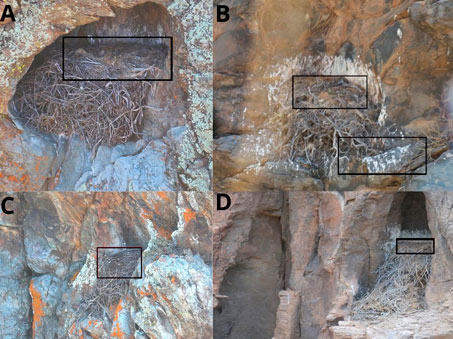
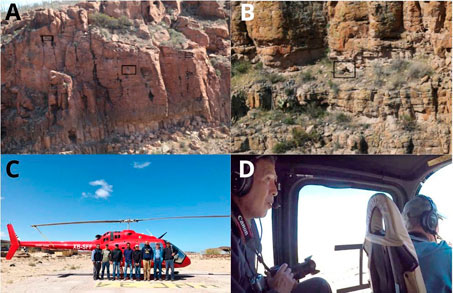
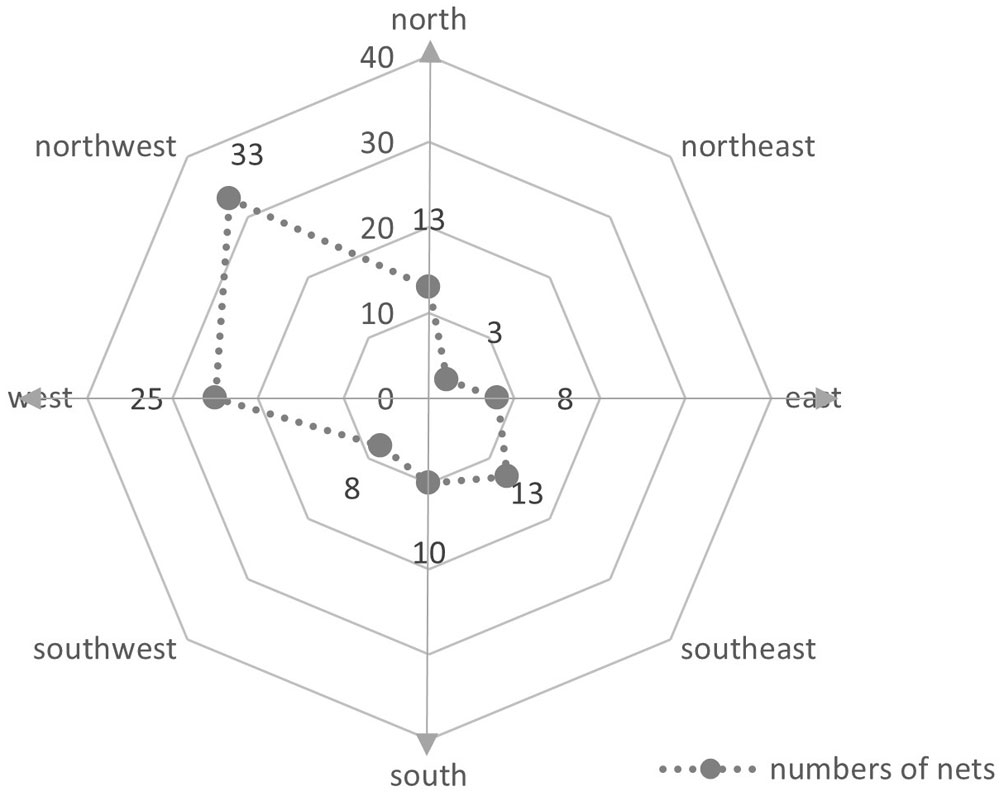
The largest number of Golden Eagle nesting clusters were recorded in Sierrita- Jaraguay with 6, followed by Sierra Libertad with 4, and Sierra San Pedro Mártir with 2 (Table 1). In this context, the frequency of identified Golden Eagle nests was dependent of the sampling route in question (c2 = 64.4, 4 df, p < 0.01) with the highest preference of nesting sites in Sierrita-Jaraguay. In a north-south trajectory the number of detected nests decreased to zero beginning at Sierra San Francisco and beyond this mountain range (Table 1). The latitudinal range of detected Golden Eagle nests was 30º39’ to 28°13’ N, with the highest frequency of nests between 29º37’ N, 114º47’ W to 29º56’ N, 114º22’ W, and decreasing to zero at latitude 27º37’ N, 113º33’ W.
Regarding the orientation of the nests detected, most of them were found oriented or exposed towards the northwest (n = 33) in Sierra San Pedro Mártir and Sierra Jaraguay with average elevations of 753 and 643 m, respectively (Fig. 4). Other nests (n = 25) were oriented towards the west at average elevations of 1,110 m (Sierra San Pedro Mártir) and 663 m (Sierra Jaraguay) (Fig. 4).
The number of detected nests of Golden Eagles had a no correlation with latitude (r = 0.116, n = 113, p = 0.446), however the number of nests showed an inverse correlation with altitude (r = -0.366, n = 113, p = 0.004). In spite of that, both factors were not correlated (r =-0.248, n = 113, p = 0.073). The number of Golden Eagle nests was different among the 5 latitude categories (c2 = 49.12, df = 4, p < 0.001), being more common in the 30º to 29º N-latitude range (Fig. 5). In terms of altitude, the highest number of nests (n = 35) during the aerial sampling was in the 601-700 m interval (Fig. 6). The number of nests was different among the 5 altitude categories (c2 = 44.66, 5 df, p < 0.001), being more common between 600 and 800 m.
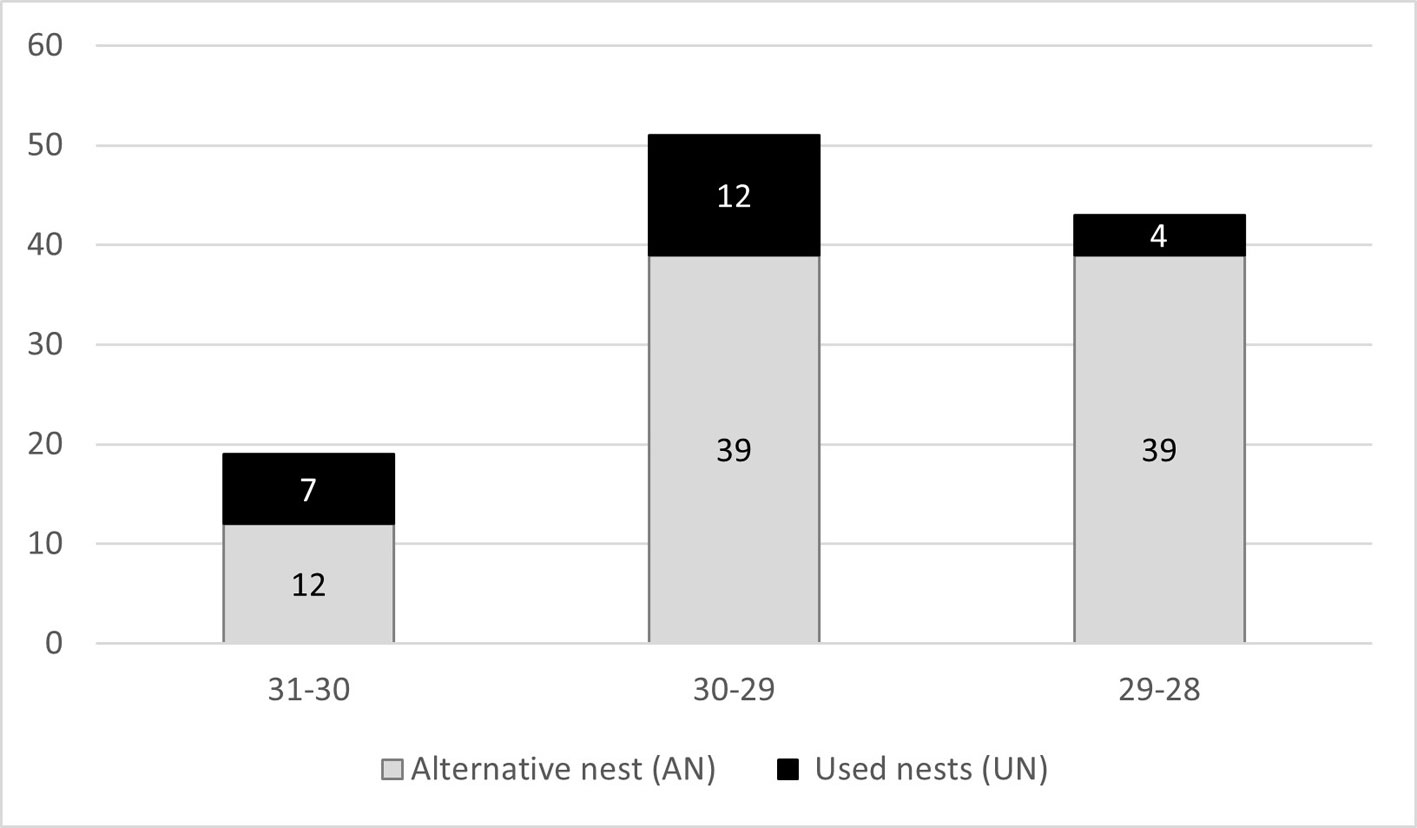
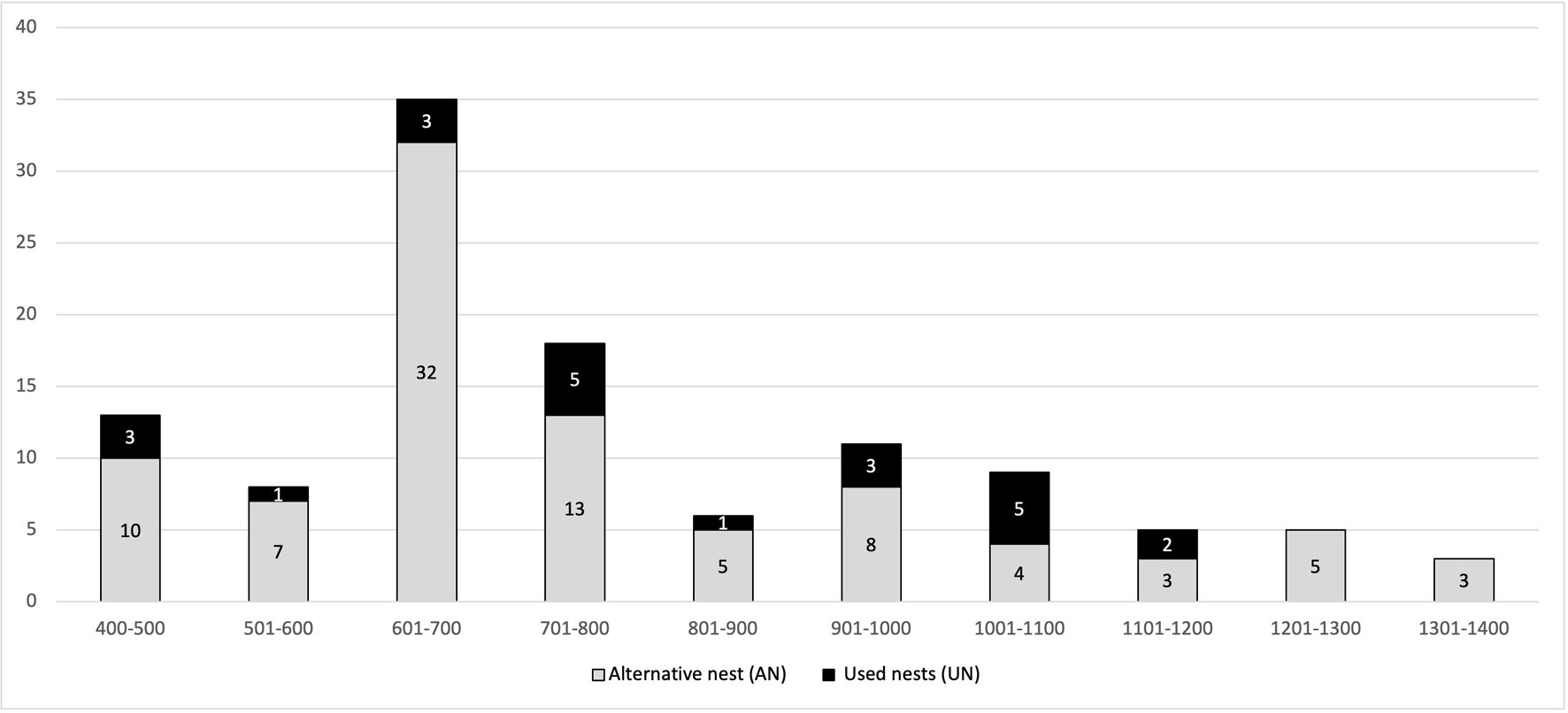
Discussion
The present study represents the first aerial census for identification and quantification of nesting sites of Golden Eagles in the central region of the Baja California Peninsula, Mexico, yielding a total of 113 detected nests along a linear transect of 1,600 km. This number of detected nests is similar to that reported by Hickman (1972) of 126 nests along a 1,609 km straight transect in southwestern Idaho, Washington, and Oregon.
The geomorphological features (e.g., cliffs, escarpment, and orientation), presence of prey, and proximity to other Golden Eagle territories, have been considered of key importance to determine the number of nests and territories in a region (Kochert & Steenhof, 2012; Marzluff et al., 1997; McGahan, 1968; Millasap et al., 2015; Watson & Duff, 2014). Several authors agree that the complex topography associated with presence of crests in the mountains are usually related to habitat preference for selection of nesting sites (Fielding et al., 2020; Miller et al., 2017; Singh et al., 2016; Tracey et al., 2018).
In our case, we recorded the largest number of nests in the La Sierrita-Sierra Jaraguay transect, which is characterized by a topographical complex of volcanic origin from the Miocene period, with ample plateaus such as Meseta del Gato, La Misión and El Rincón, among others, all of them falling on ample valleys of alluvial substrate (Pallares et al., 2008). The majority of the photographed nests exhibited a northwest (n = 33) and west (n = 25) orientation, where topographic conditions and foraging sites appear more favorable, a similar pattern as that seen in the western USA (Katzner et al., 2020; Millsarp et al., 2015; Steenhof et al., 2017; Watson, 2010; Wiens et al., 2021) and northwestern Mexico (De León-Girón et al., 2016; Morales-Yañez et al., 2023; Rodríguez-Estrella et al., 2020).
Regarding the latitudinal gradient, the highest abundance of nests (n = 57) was recorded between 30º and 29º N, at APFFVC. This area is characterized by a combination of mountain biotopes with steep cliffs and ample valleys (plateaus) that promote foraging and nesting sites for Golden Eagles (Sergio, Marchesi, & Pedrini, 2004, Sergio, Marchesi, Pedrini, Ferrer et al., 2004, Sergio et al., 2005). Morales-Yañez et al. (2023) reported the highest number of Golden Eagle nests in the Janos Biosphere Reserve, Chihuahua, México (30º18’ N, 108º48’ W to 31º11’N, 108º30’ W) associated to topographies with rough terrain, slopes, and altitudes (20 m asl), which are key for the concentration of alternative and used nests. South of Sierra San Francisco, important livestock (goats) and mining activities as well as human settlements were identified during the aerial samplings, which combined could be affecting the establishment of pairs of Golden Eagles. The decrease in nesting sites could be due mainly to the presence of human settlements, although some reproductive pairs have shown a significant ability to adapt to these circumstances, if no direct alterations are made to the core zone of the nesting territory (Conanp, 2008; De León et al., 2016; Rodríguez-Estrella, 2002; Rodríguez-Estrella et al., 2020; Wieners et al., 2022).
Satellite tracking of Golden Eagles in San Diego County, California (Poessel et al., 2022; Wiens et al., 2022), showed that some individuals move towards the south crossing the USA-Mexico border, visiting the same sites where we found nests (used and alternative) in the central part of the Baja California Peninsula. It is fundamental to establish permanent monitoring programs for this species at different spatial and temporal scales, allowing the generation of new research lines for this Mexican emblematic species.
Acknowledgements
This study was financed by the System of Protected Areas of México (Conanp) and the Global Environment Facility (GEF) via Program of the United Nations for Development in Mexico (UNDP). We thank Eduardo Ponce, Benito Bermúdez, Dennise Morales, and Edgar González from the United Nations Program (UNDP). Oswaldo Santillán of the Procuraduría Federal de Protección al Ambiente (Profepa) of Mexico. Pilots Eduardo Castro and Raymond Lee for the support during the aerial census. Jesús Dávila Ángulo Vizcarra, Jesús Omar Robles-Calvo (AF Flotilla), Espacios Naturales y Desarrollo A.C., Martha Caballero, Lizardo Cruz and Hortensia Ahumada, Mohamed Saad, Hiram Lecuanda, Saruhén Ávila-Moreno, and Tonatiuh Gaona-Melo for logistical field support. The monitoring permit for this study was provided by the Dirección General de Vida Silvestre de México (permit: DGSVS/02414/21). This study is dedicated to the memory of Ricardo Rodríguez-Estrella, who was a leader in the study and conservation of Mexican raptors, especially of Golden Eagle. Finally, we thank Alberto Macías-Duarte and one anonymous reviewer for the useful suggestions that improved the content of the manuscript.
References
Bates, J. W., & Moretti, M. O. (1994). Golden Eagle (Aquila chrysaetos) population ecology in eastern Utah. Great Basin Naturalist, 54, 248–255.
Bravo-Vinaja, M. G., Mireles, C., Zúñiga, J., & Carreón, E. (2015). Composición y amplitud de la dieta del águila real en Chihuahua, México. Acta Zoológica Mexicana, 31, 116–119. https://doi.org/10.21829/azm.2015.311523
Brown, D. E., & Lowe, C. H. (1980). Biotic communities of the Southwest. Gen. Tech. Rep. RM-GTR-78. U.S. Department of Agriculture, Forest Service, Rocky Mountain Forest, and Range Experiment Station
Conanp (Comisión Nacional de Áreas Naturales Protegidas). (2000). Programa de Manejo Reserva de la Biosfera El Vizcaíno. México D.F. https://www.conanp.gob.mx/datos_abiertos/DGCD/49.pdf
Conanp (Comisión Nacional de Áreas Naturales Protegidas). (2008). Programa de Acción para la Conservación de la especie (PACE): águila real (Aquila chrysaetos). Ciudad de México. https://www.gob.mx/conanp/documentos/programa-de-accion-para-la-conservacion-de-la-especie-pace-aguila-real-aquila-chrysaetos
Conanp (Comisión Nacional de Áreas Naturales Protegidas). (2013). Programa de Manejo del Área de Protección de Flora y Fauna Silvestre Valle de Los Cirios. México D.F. https://www.dof.gob.mx/nota_detalle.php?codigo=5294191&fecha=02/04/2013
De León-Girón, G., Rodríguez-Estrella, R., & Ruiz-Campos G. (2016). Current distribution status of Golden Eagle (Aquila chrysaetos) in Northwestern Baja California, Mexico. Revista Mexicana de Biodiversidad, 87, 1328–1335. https://doi.org/10.1016/j.rmb.2016.10.003
Delgadillo, J. (1998). Florística y ecología del norte de Baja California. Ensenada: Universidad Autónoma de Baja California.
Delgadillo, J. (2004). El bosque de coníferas de la Sierra de San Pedro Mártir, Baja California. México D.F.: Semarnat – Instituto Nacional de Ecología.
Dixon, J. B. (1937). The Golden Eagle in San Diego County, California. The Condor, 39, 49–56.
Dunk, J. R., Woodbridge, B., Lickfett, T. M., Bedrosian, G., Noon, B. R., LaPlante, D. W. et al. (2019). Modeling spatial variation in density of Golden Eagle nest sites in the western United States. Plos One, 14, e0223143. https://doi.org/10.1371/journal.pone.0223143
Farías, V., Hernández, O., Arizmendi, M. C., Téllez, O., Botello, F., & Olivares, S. J. (2016). Registro notable de águila real (Aquila chrysaetos) en la Reserva de la Biosfera Tehuacán-Cuicatlán, Puebla, México. Revista Mexicana de Biodiversidad, 87, 1153-1158. https://doi.org/10.1016/j.rmb.2016.06.001
Fielding, A. H., Haworth, P. F., Anderson, D., Benn, S., Dennis, R., & Weston, E. (2020). A simple topographical model to predict Golden Eagle (Aquila chrysaetos) space use during dispersal. Ibis, 162, 400–415. https://doi.org/10.1111/ibi.12718
Flesch, A. D., Rodríguez-Estrella, R., Gallo-Reynoso, J. P., Armenta-Méndez, L., & Montiel-Herrera, M. (2020). Distribution and habitat of the Golden Eagle (Aquila chrysaetos) in Sonora, Mexico, 1892-2019. Revista Mexicana de Biodiversidad, 91, e91305691. https://doi.org/10.22201/ib.20078706e.2020.91.3056
Google Earth. (2005). Google Earth. Software. Google LLC. https://nucleovisual.com/como-citar-google-earth/
Guerrero-Cárdenas, I. G., Gallina-Tessaro, P., Álvarez-Cárdenas, S., & Mesa-Zavala, E. (2012). Avistamientos recientes de águila real (Aquila chrysaetos) en la sierra El Mechudo, Baja California Sur, México. Revista Mexicana de Biodiversidad, 83, 397‒401. https://doi.org/10.7550/rmb.26780
Harper, A., Vanderplank, S., & Rebman, J. (2021). A guide to the flora of the Sierra de San Pedro Mártir. Fort Worth, TX & Sacramento, CA.: BRIT Press &California Native Plant Society.
Hickman, G. L. (1972). Aerial determination of Golden Eagle Nesting Status. Journal of Wildlife Management, 36, 1289-1292. https://doi.org/10.2307/3799266
Hunt, W.G. (1998). Raptors floaters at Moffats equilibrium. Oikos, 82, 191-197.
Hunt, W. G., Wiens, J. D., Law, P. R., Fuller, M. R., Hunt, T. L., Driscoll, D. E. et al. (2017). Quantifying the demographic cost of human-related mortality to a raptor population. Plos One, 12, 2e0172232. https://doi.org/10.1371/journal.pone.0172232
INEGI (Instituto Nacional de Estadística, Geografía e Informática). (2010). Carta topográfica. Mexicali. Escala 1:1000 000. México D.F.: Instituto Nacional de Estadística y Geografía. https://www.inegi.org.mx/app/biblioteca/ficha.html?upc=702825718312
INEGI (Instituto Nacional de Estadística y Geografía). (2013). Continuo de Elevaciones Mexicano 3.0 (CEM 3.0). https://www.inegi.org.mx/app/biblioteca/ficha.html?upc=889463842781
INEGI (Instituto Nacional de Estadística y Geografía e informártica). (2018). Conjunto de datos vectoriales de uso del suelo y vegetación. Escala 1:250 000. Serie VII. Conjunto Nacional (https://www.inegi.org.mx/app/biblioteca/ficha.html?upc=889463842781)
Jollie, M. (1947). Plumage changes in the Golden Eagle. Auk, 64, 549–576. https://doi.org/10.2307/4080715
Katzner, T. E., Kochert, M. N., Steenhof, K., McIntyre, C. L., Craig, E. H., & Miller, T. A. (2020). Golden Eagle (Aquila chrysaetos), version 2.0. In P. G. Rodewald, & B. K. Keeney (Eds.), Birds of the World. Cornell Laboratory of Ornithology, Ithaca, NY, USA. https://doi.org/10.2173/bow.goleag.02
Kochert, M. N., & Steenhof, K. (2012). Frequency of nest use by Golden Eagles in southwestern Idaho. The Journal of Raptor Research, 46, 239–247. https://doi.org/10.3356/jrr-12-00001.1
Marzluff, J. M., Knick, S. T., Vekasy, M. S., Schueck, L. S., & Zarriello, T. J. (1997). Spatial use and habitat selection of Golden Eagles in southwestern Idaho. Auk, 114, 673–687. https://doi.org/10.2307/4089287
McGahan, J. (1968). Ecology of the Golden Eagle. Auk, 85,1–12.
Miller, T. A., Brooks, R. P., Lanzone, M. P., Cooper, J., O’Malley, K., Brandes, D. et al. (2017). Summer and winter space use and home range characteristics of Golden Eagle (Aquila chrysaetos) in eastern North America. The Condor, 119, 697–719. https://doi.org/10.1650/CONDOR-16-154.1
Millsap, B. A., Grubb, T. G., Murphy, R. K., Swem, T., & Watson, J. W. (2015). Importance of the conservation of alternative nests of Golden Eagles. Global Ecology and Conservation, 3, 234–241. https://doi.org/10.1016/j.gecco.2014.11.017
Morales-Yañez, I., Rodríguez-Estrella, R., & Gatica-Colima, A. G. (2023). Selección de sitios de anidacion por el águila real Aquila chrysaetos (Linnaeus, 1758) (Accipitriformes:Accipitridae) en Janos, Chihuahua, México.
Acta Zoológica Mexicana, 39, 1–14. https://doi.org/10.21829/azm.2023.3912564
Nielson, R. M., Mcmanus, L., Rintz, T., Mcdonald, L. L., Murphy,
R. K., Howe, W. H. et al. (2017), Monitoring abundance of Golden Eagles in the western United States. Journal Wildlife Management, 78, 721–730. https://doi.org/10.1002/jwmg.704
Oyervides-Figueroa, R. (2019). Ensamble y anotación del genoma mitocondrial del águila real (Aquila chrysaetos) del noroeste de Baja California (Tesis de maestría). Instituto de Investigaciones Oceanológicas. Universidad Autónoma de Baja California. Ensenada, Baja California, México.
Pagel, J. E., Whittington, D. M., & Allen, G. T. (2010). Interim Golden Eagle technical guidance: inventory and monitoring protocols; and other recommendations in support of Golden Eagle management and permit issuance. U.S. Fish and Wildlife Service, Carlsbad, CA. Available at: https://tethys.pnnl.gov/sites/default/
Pallares, C., Maury, R. C., Bellon, H., Royer, J. Y., Calmus, T., Aguillón-Robles, A. et al. (2007). Slab-tearing following ridge-trench collision: evidence from Miocene volcanism in Baja California, Mexico. Journal of Volcanology and Geothermal Research, 161, 95–117. https://doi.org/10.1016/j.jvolgeores.2006.11.002
Palmer, R. S., Mineau, P., Fletcher, M. R., Glaser, L. C., Thomas, B. N. J., Wilson, L. K. et al. (1988). Handbook of North American Birds. Raptors. Pt. 2 (Vol. 5). New Haven, Connecticut: Yale University Press.
Phillips, R. L., Cummings J. L., & Berry J. D. (1991). Responses of breeding Golden Eagles to relocation. Biological Conservation, 19, 430–434. https://www.jstor.org/stable/3782
153
Poessel, S. A., Woodbridge, B., & Smith, B. W. (2022). Interpreting long-distance movements of non-migratory Golden Eagles: Prospecting and nomadism? Ecosphere, 13, 1–17, https://doi.org/10.1002/ecs2.4072
Pool, D. B., Panjabi, A. O., Macías-Duarte, A., & Solhjem ,D. M. (2014). Rapid expansion of croplands in Chihuahua, Mexico threatens declining North American grassland bird species. Biological Conservation, 170, 274–281. https://doi.org/10.1016/j.biocon.2013.12.019
Postupalsky, S., F. N., Hamerstrom, B. E., & Harrell, R. R. (1974). Raptor reproductive success: some problems with methods, criteria and terminology. In F. N. Hamerstrom Jr., B. E. Harrel, & R. R. Olendroff (Eds.), Raptor Research Report No. 2 (pp. 21–31). Inc. Vermilllion, S.D. U.S.A. Raptor Research Foundation.
Rebman, J. P., & Roberts, N. C. (2012). Baja California plant field guide, 3rd Edition. San Diego, CA: San Diego Natural History Museum Publication and Sunbelt Publication Inc.
Rodríguez-Estrella, R. (2002). A survey of Golden Eagles in northern Mexico (1984), and some recent records in central and southern Baja California Peninsula. Journal of Raptor Research, 36, 3‒9.
Rodríguez-Estrella, R., Lafón, A., De León -Girón, G., Nocedal, J., Chapa, L., Scott, L. et al. (2020). Informe del Programa de monitoreo del águila real en México. Comisión Nacional para el Conocimiento y Uso de la Biodiversidad/ Centro de Investigaciones Biológicas del Noreste. México D.F. Available: http://www.conabio.gob.mx/institucion/proyectos/resultados/JB004_Anexo_Programa_Monitoreo_Aguila_Real.pdf
Rodríguez-Estrella, R., Llinas, J. G., & Cancino, J. (1991). New Golden Eagle records from Baja California. Journal of Raptor Research, 25, 68‒71.
Sergio, F., Marchesi, L., & Pedrini, P. (2004). Integrating individual habitat choices and regional distribution of a biodiversity indicator and top predator. Journal of Biogeography, 31, 619‒628. https://doi.org/10.1046/j.1365-2699.2003.01002.x
Sergio, F., Marchesi, L., Pedrini, P., Ferrer, M., & Penteriani, B. (2004). Electrocution alters the distribution and density of a top predator, the Eagle owl Bubo bubo. Journal of Applied Ecology, 41, 836‒845. https://doi.org/10.1111/j.0021-8901.2004.00946.x
Sergio, F., Newton, I., & Marchesi, L. (2005). Top predators and biodiversity. Nature, 436, 192. https://doi.org/10.1038/436192a
Sharpe, R. S., Silcock, W. R., & Jorgensen, J. G. (2001). The Birds of Nebraska: their distribution and temporal occurrence. Lincoln: University of Nebraska Press.
Singh, N. J., Moss, E., Hipkiss, T., Ecke, F., Dettki, H., & Sandström, P. (2016). Habitat selection by adult golden eagles Aquila chrysaetos during the breeding season and implications for wind farm establishment. Bird Study, 63, 233–240. https://doi.org/10.1080/00063657.2016.1183110
Slevin, J. R. (1929). A contribution to our knowledge of the nesting habits of the Golden Eagle. Proceedings of the California Academy of Sciences, 18, 45–71.
Sokal, R. R., & Rohlf, F. J. (1995). Biometry: the principles and practice of statistics in biological research, 3rd edition. New York: W.H. Freeman and Co.
Steenhof, K., Kochert, M. N., McIntyre, C. L., & Brown, J. L. (2017). Coming to terms about describing Golden Eagle reproduction. Journal of Raptor Research, 51, 378–390. https://doi.org/10.3356/jrr-16-46.1
Tack, J. D., Noon, B. R., Bowen, Z. H., & Fedy, B. C. (2020). Ecosystem Processes, land Cover, Climate, and Human Settlement Shape Dynamic Distributions for Golden Eagle across the western US. Animal Conservation, 23, 72–82. https://doi.org/10.1111/acv.12511
Thorne, R. F., Moran, R. V., & Minich, R.A. (2010). Vascular plants of the high Sierra San Pedro Mártir, Baja California, México: an annotated checklist. Aliso, 28, 1–57. https://scholarship.claremont.edu/aliso/vol28/iss1/2/
Tracey, J. A., Madden, M. C., Molden, J. C., Sebes, J. B., Bloom, P. H., & Fisher, R. N. (2020). A clarification on the effects of urbanization on Golden Eagle (Aquila chrysaetos) habitat selection. US Geological Survey Open-File Report 2020-1110. Reston, VA: U.S. Geologycal Survery 5. https://doi.org/10.3133/ofr20201110
Tracey, J. A., Madden, M. C., Sebes, J. B., Bloom, P. H., Katzner, T. E., & Fisher, R. N. (2018). Biotelemetry data for Golden Eagles (Aquila chrysaetos) captured in coastal southern California, November 2014-February 2016. In Data Series. US Geological Survey. https://doi.org/10.3133/ds994
U.S.F.W.S. (U.S. Fish & Wildlife Service). (2016). Bald and Golden Eagles: population demographics and estimation of sustainable take in the United States, 2016 update. U.S. Fish and Wildlife Service, Division of Migratory Bird Management, Washington D.C., USA https://www.fws.gov/media/population-demographics-and-estimation-sustainable-take-united-states-2016-update
Watson, J. (2010). The Golden Eagle, Second ed. London: T & AD Poyser.
Watson, J. W., & Duff, R. W. (2014). Home range and resource selection by GPS-monitored adult golden eagles in the Columbia Plateau ecoregion: implications for wind power development. Journal of Wildlife Management, 78, 6, 1012–1021. https://doi.org/10.1002/jwmg.745
Wiens, D. J., Bloom, P., Madden, M. C., Kolar, P. S., Tracey, J. A., & Fisher, R. N. (2022). Golden Eagle occupancy survey and monitoring strategy in coastal southern California, United States. Frontiers in Ecology and Evolution, 9, 66792. https://doi.org/10.3389/fevo.2021.665792

